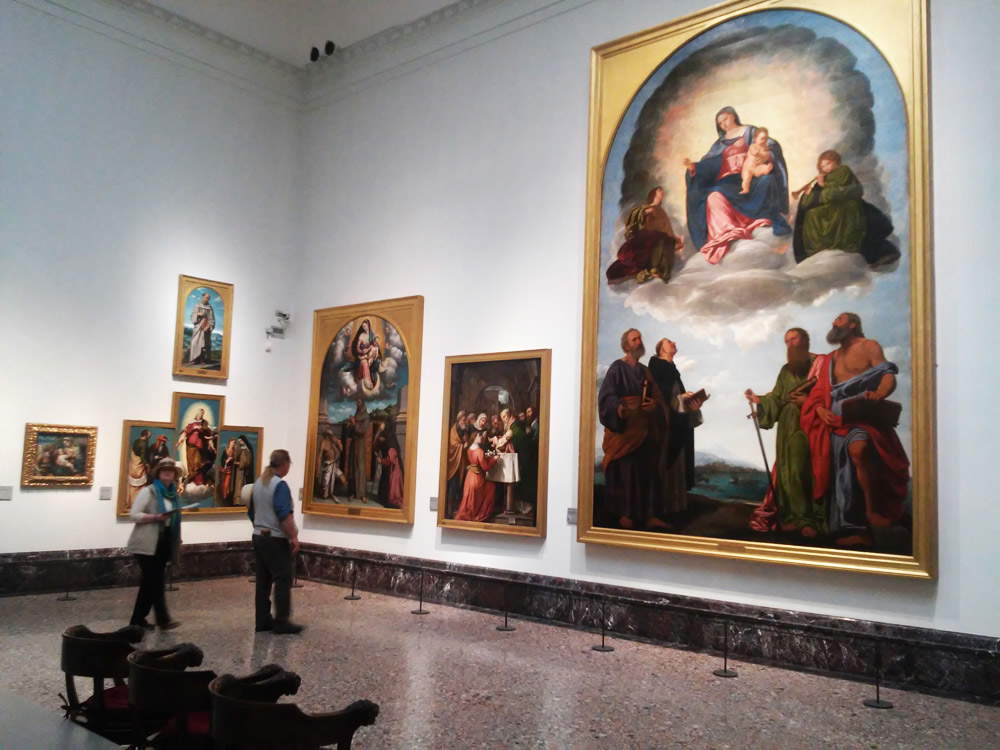The question with which I decided to title this article is obviously rhetorical. In reality, the problems are there. A museum should be a basis for building our sense of citizenship and not simply a location for shows intended for so-called VIPs, or presumed VIPs. A museum should include and, to avoid consequent conflicts with that goal, should eschew any event to which the label of “exclusive” can be attributed, as is a ball reserved exclusively for a thousand very select guests. A museum, in essence, should be a palace of culture and not a palace of parties, all the more so if the latter are reserved for a small swarm of wealthy guests who gush dripping with terschorean fury.
 |
| Room XIV of the Brera Art Gallery. Photo: Finestre Sull’Arte |
However, we also need to analyze individual situations a little more thoroughly, avoiding stopping at the level of pure ideology, which will surely get many of us to agree, but which is often not enough to find adequate answers. We should, in other words, ask ourselves whether it is not the case every now and then to compromise: we have often written about it on these pages, and we repeat it after the Brera Ball, the brainchild of the Pinacoteca’s director, James Bradburne, and critic Philippe Daverio. Without wishing to enter into judgments on the parterre (those who are curious to read the names of some of the participants, or to see the photos of the event, will have little difficulty in going to Google and entering a couple of keywords suitable for the purpose), we can just say that it was certainly a ball for a few guests. Of a social event, in short, as there are many in Milan and other cities in Italy. But it is necessary to point out that the whole thing took place during hours closed to the public and, at least as far as we know, the normal enjoyment by the public was in no way affected by the great summer ball.
It can also be asserted that the Pinacoteca did not derive any direct economic income from the operation, since its spaces were not rented to a tenant who requested it: it was a ball organized by the Pinacoteca di Brera itself, which probably conceived it as a mere marketing operation. To put it bluntly, someone may have thought, "since, for some potential supporters, the sight of Mantegna’s Dead Christ, Piero della Francesca’s Montefeltro Altarpiece or Raphael’s Wedding might not be a sufficient condition for an approach to the museum, we are making a strong case for a dance evening aimed at opening the hearts of the most reluctant. Marketing (which, as we have often pointed out, is not a word to be avoided with horror) is also done in this way. And, again, the ball also took the form of a sort of thanksgiving to those who have guaranteed handouts to the Brera Art Gallery: indeed, among the guests were several individuals who have supported the museum. Agreed: a donation that wants to be truly such should be disinterested. But, frankly, we do not feel like condemning the Pinacoteca if the latter decided to offer its supporters a party as a sign of gratitude. Could the director have organized it elsewhere without committing the Pinacoteca’s courtyard? Perhaps so, but it clearly would not have had the same appeal in the eyes of the audience.
Is using the courtyard of a museum for a party a scientifically ignoble move? Actually, I don’t see where the problem is: a dance in the courtyard does not involve the scientific apparatus of an institution, and a museum can also host events, especially where the museum should also become a space for gathering and community building. You just have to know how to do it intelligently (as, for that matter, is now the case in many cases) and by fostering inclusion. Has this not been the case at Brera? Was the museum not inclusive enough? We all cultivate the dream of a museum that does not close its doors to anyone and does not make selections among the public. But we must also ask ourselves whether, at this historical moment, this path cannot also be built with evenings such as the one dedicated to the “Brera Ball,” which have no repercussions on either visitors or works, which do not damage the image of the institution, and which could be taken as opportunities to support the museum.
Warning: the translation into English of the original Italian article was created using automatic tools. We undertake to review all articles, but we do not guarantee the total absence of inaccuracies in the translation due to the program. You can find the original by clicking on the ITA button. If you find any mistake,please contact us.